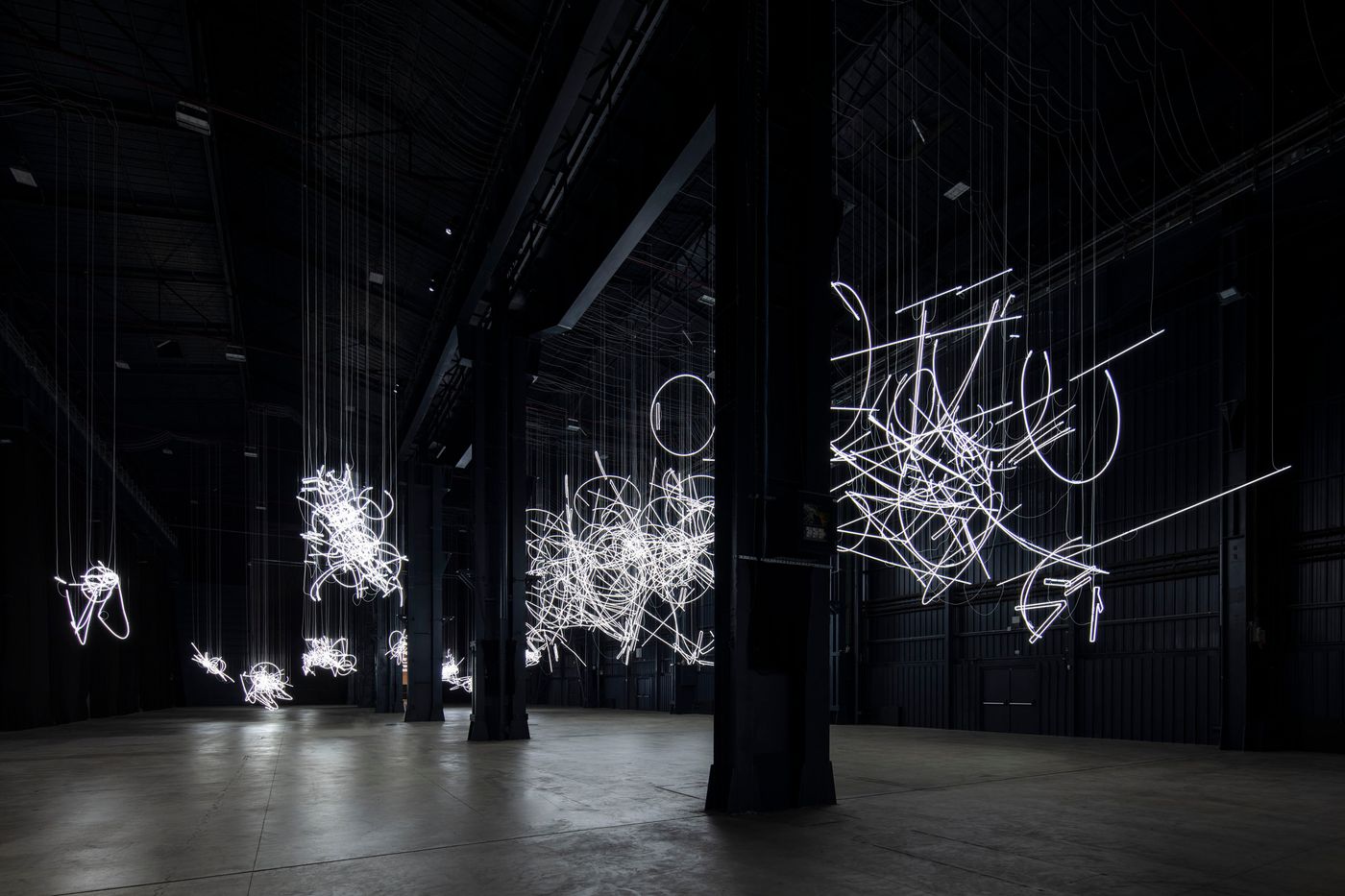
The Ethereal Effulgence of Cerith Wyn Evans' Operatic Exhibition at Pirelli HangarBicocca in Milan
Words by Eric David
Location
Milano, Italy
The Ethereal Effulgence of Cerith Wyn Evans' Operatic Exhibition at Pirelli HangarBicocca in Milan
Words by Eric David
Milano, Italy
Milano, Italy
Location
An immersive sensory experience awaits visitors at Milan’s Pirelli HangarBicocca courtesy of Welsh conceptual artist Cerith Wyn Evans, whose largest-ever solo exhibition “....the Illuminating Gas” fills the former industrial facility with suspended neon sculptures and distended soundscapes. Unfolding across 5,000 square-metres, 24 monumental installations, earlier sculptures and new productions synthesize a complex constellation of light and sound that showcase Wyn Evans’ exploration of these ephemeral mediums, highly refined aesthetic and enduring preoccupation with the subjective nature of perception. Taking advantage of the artist’s practice of repeating visual and textual sources across different bodies of work, and his predilection for light as his materia prima, curators Roberta Tenconi and Vicente Todolí have imbued the exhibition with formal cohesion, theatrical continuity and operatic drama.

Cerith Wyn Evans, The Illuminating Gas... (after Oculist Witnesses), 2015 © Cerith Wyn Evans. Courtesy White Cube. Photo: George Darrell.
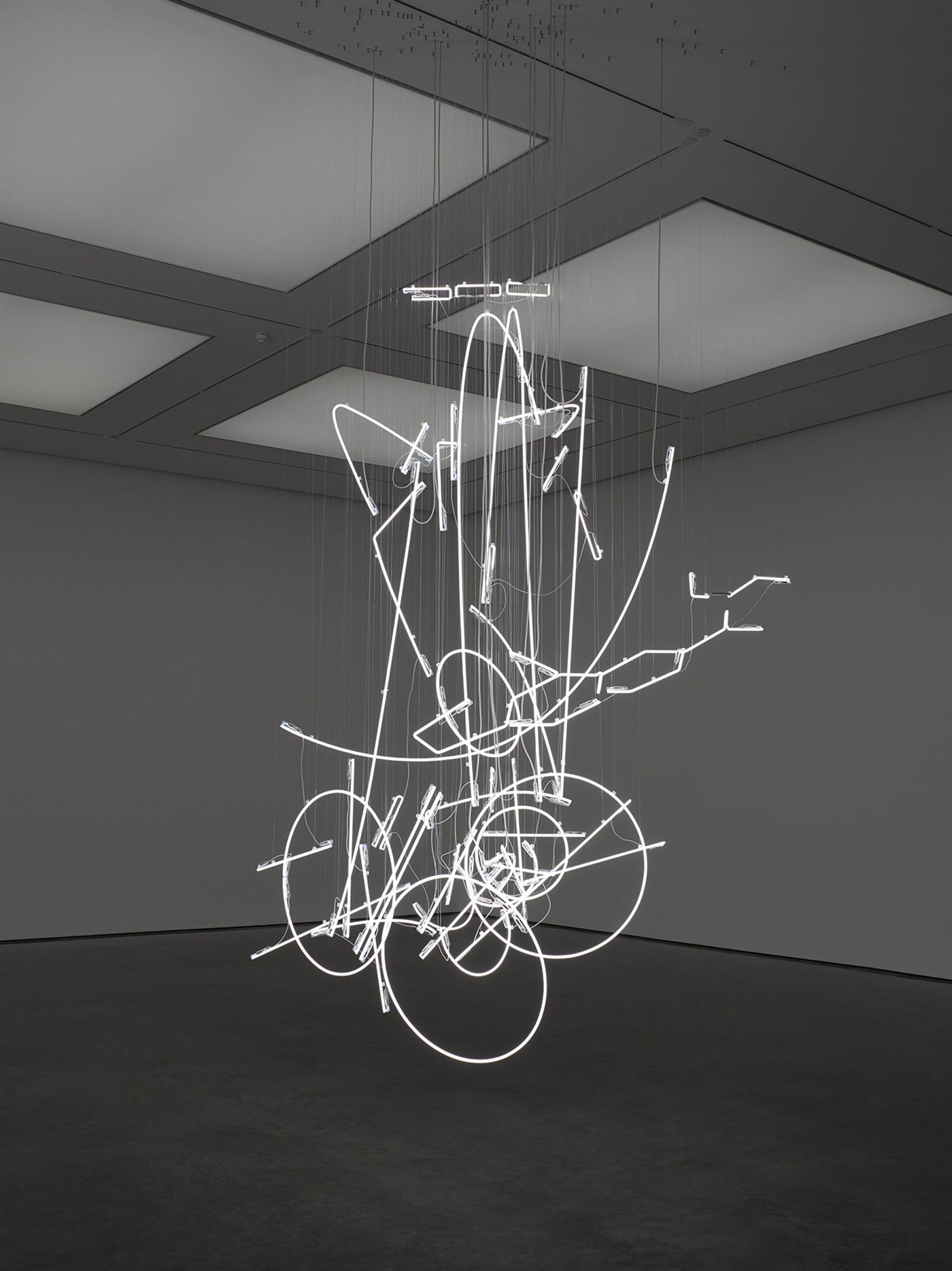
Cerith Wyn Evans, Neon Forms (after Noh III), 2015 © Cerith Wyn Evans. Courtesy White Cube. Photo: George Darrell.

Cerith Wyn Evans, Radiant fold (…the Illuminating Gas), 2017-18. Installation view, Amgueddfa Cymru – National Museum Wales, Cardiff, 2018. © Cerith Wyn Evans. Courtesy Amgueddfa Cymru – National Museum Wales. Photo: Robert Maggs.
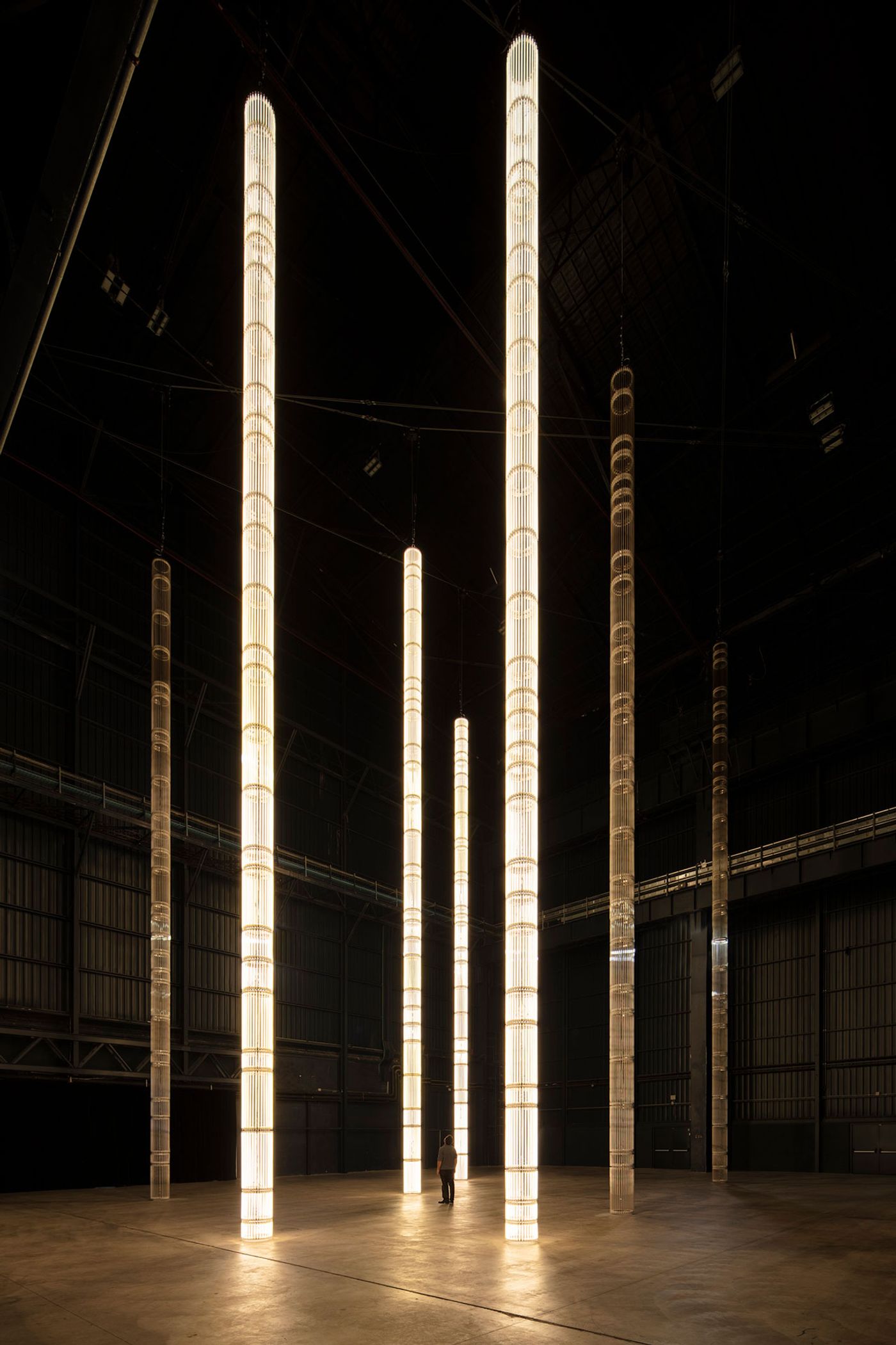
Cerith Wyn Evans, StarStarStar/Steer (totransversephoton), 2019. Installation view at Pirelli HangarBicocca, Milan, 2019. Courtesy of the artist; White Cube and Pirelli HangarBicocca. Produced with the technical support of INELCOM, Madrid. Photo: Agostino Osio

Cerith Wyn Evans, StarStarStar/Steer (totransversephoton), 2019. Installation view at Pirelli HangarBicocca, Milan, 2019. Courtesy of the artist; White Cube and Pirelli HangarBicocca. Produced with the technical support of INELCOM, Madrid. Photo: Agostino Osio
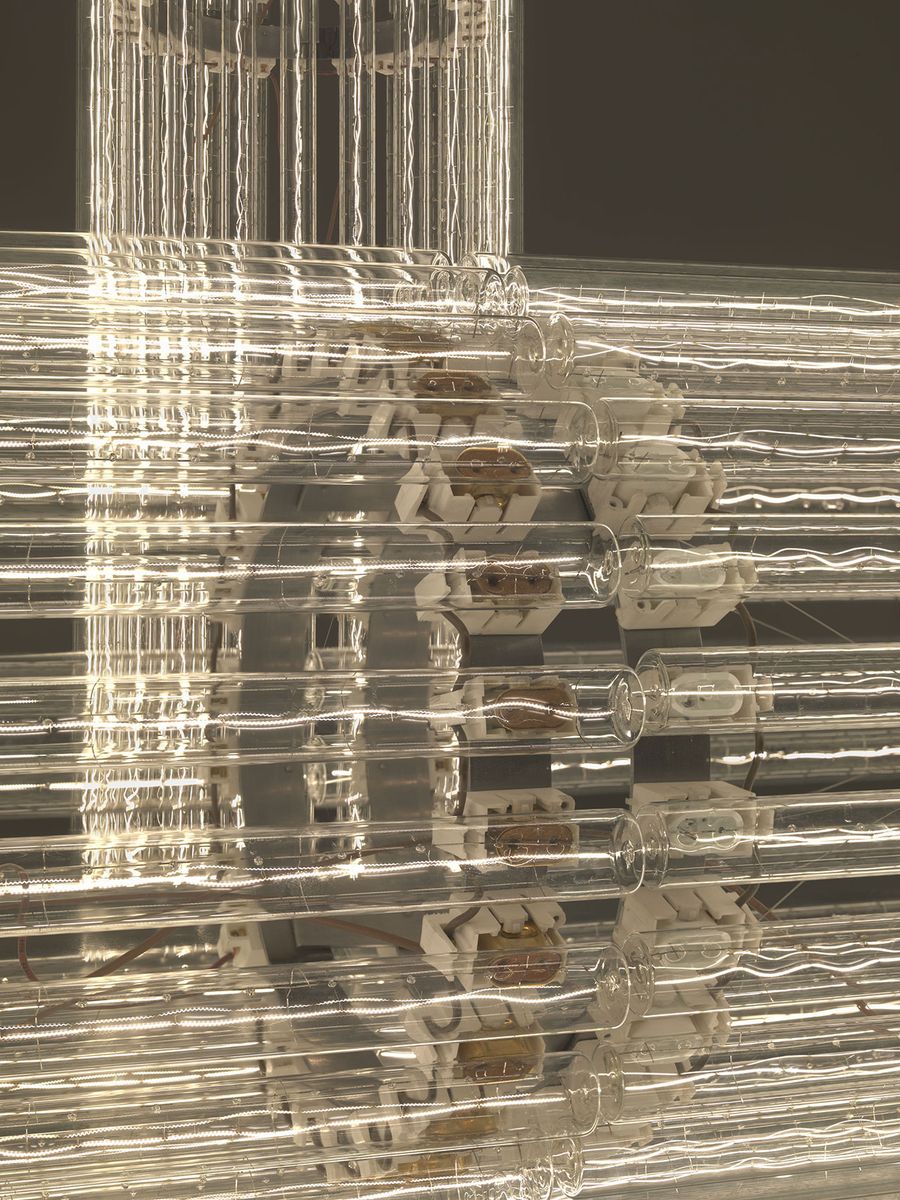
Cerith Wyn Evans, Column (Assemblages) VIII, 2010 (detail) © Cerith Wyn Evans. Courtesy White Cube. Photo: Todd-White Art Photography.

Cerith Wyn Evans, Column (Assemblages) I, 2010 © Cerith Wyn Evans. Courtesy White Cube. Photo: Todd-White Art Photography.
Starting his artistic career as a filmmaker, Wyn Evans gained acclaim for his experimental films before turning, in the 1990s, to sculptures, installations, photographs and performative interventions that focus on language and perception. Underpinned by a cinematic sensibility, his work draws from a diverse body of references and quotations, from literature, to music, to astronomy, which he decontextualizes and translates into an ethereal language of light and sound.
His concept-driven approach, and especially the interrelation between language and visual perception, alludes to ground-breaking artist Marchel Duchamp whose work Wyn Evans often references both formally and conceptually. In fact, the title of the exhibition, “....the Illuminating Gas”, takes its name from Duchamp’s final work, Étant donnés: 1. La chute d’eau, 2. Le gaz d’éclairage, (Given: 1. The Waterfall, 2. The Illuminating Gas), which he worked on for 20 years towards the end of his career. Not coincidentally, the artworks on display at Pirelli HangarBicocca also span a 20-year period, implying that everything in the exhibition, from the smallest twist of the neon sculptures, to the rhythm of the sound installations, serves a purpose.
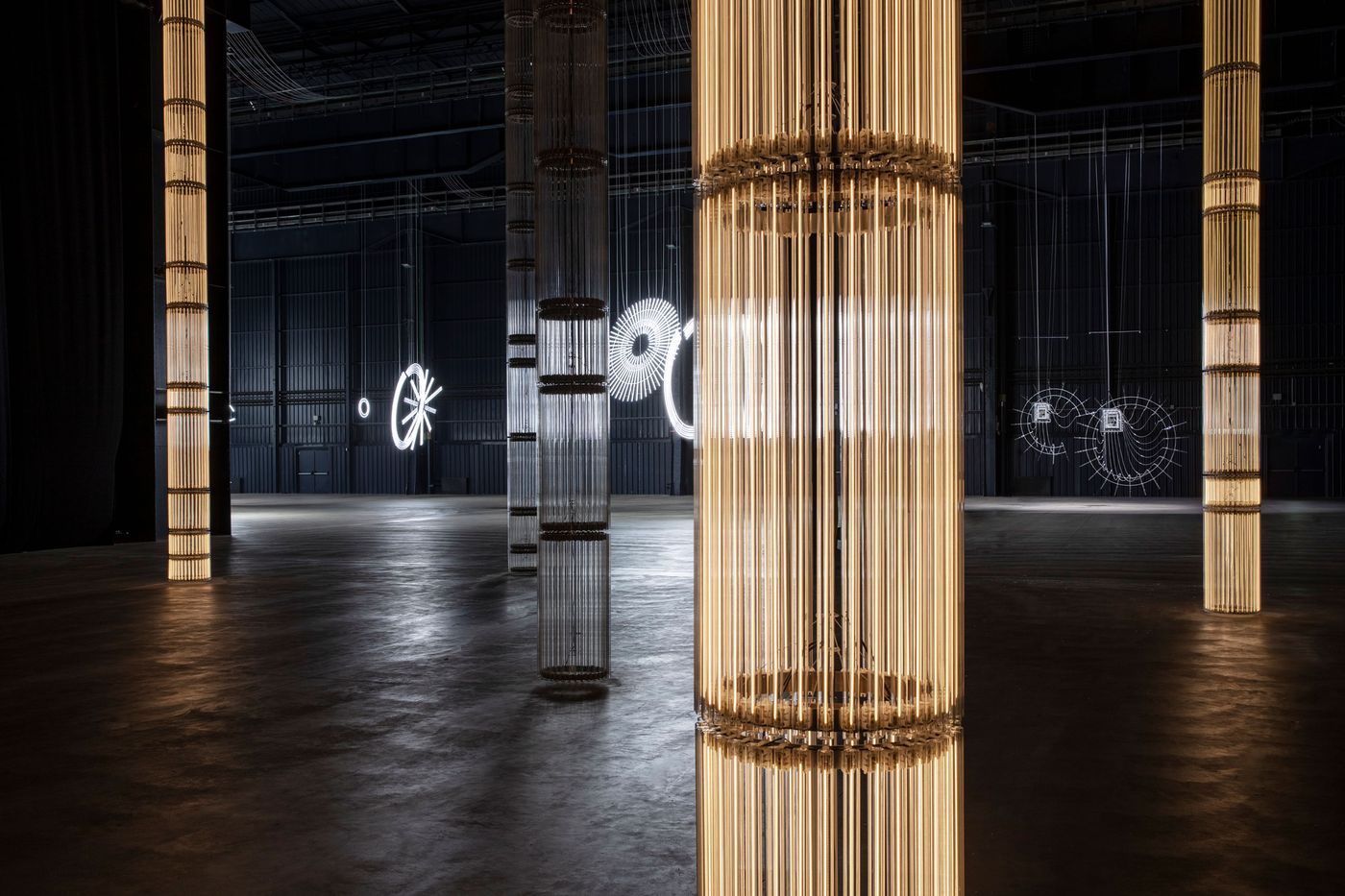
Cerith Wyn Evans, “….the Illuminating Gas”, exhibition view at Pirelli HangarBicocca, Milan, 2019. Courtesy of the artist and Pirelli HangarBicocca, Milan. Photo: Agostino Osio.
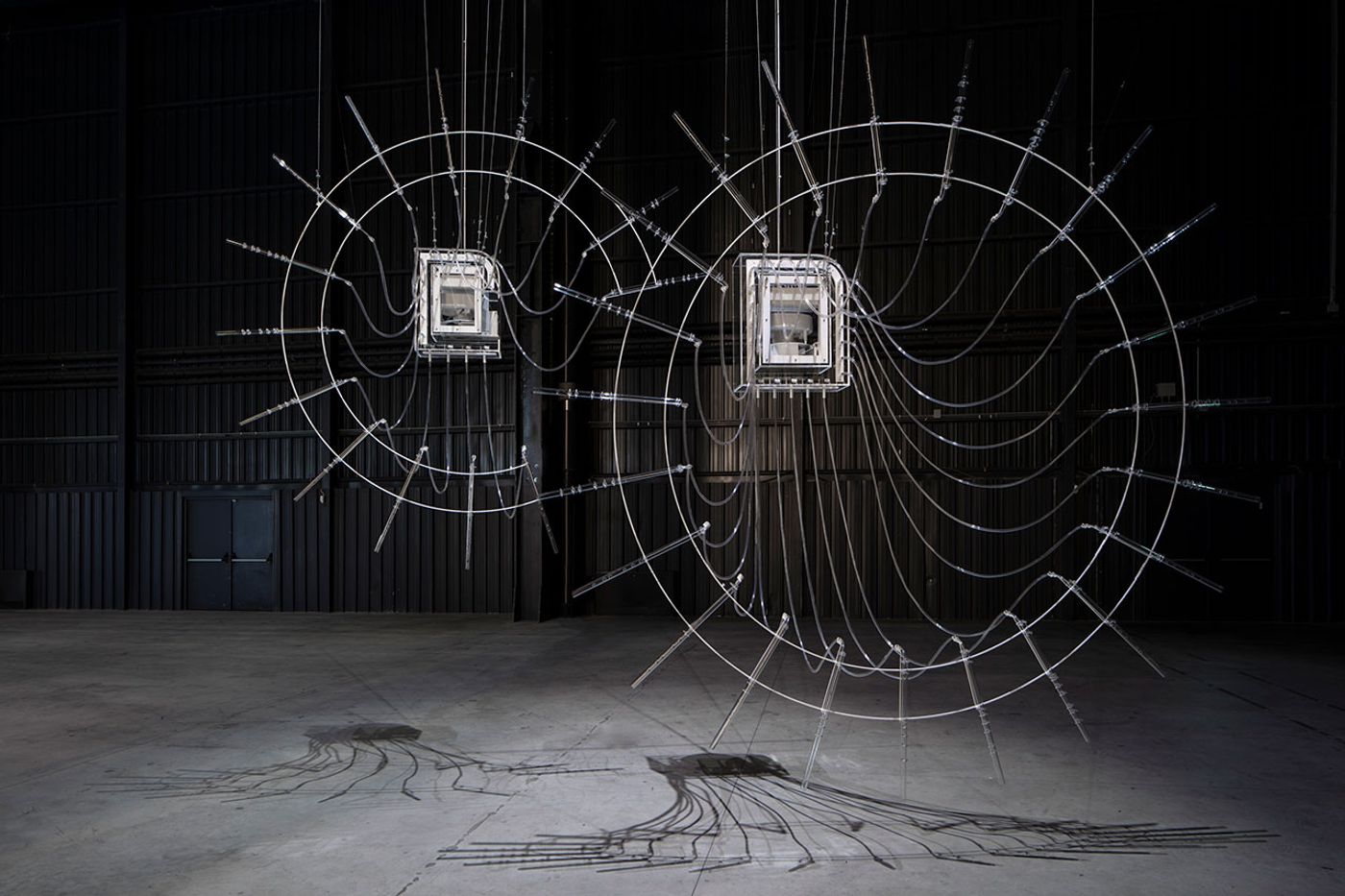
Cerith Wyn Evans, Composition for 37 Flutes (in two parts), 2018. Installation view at Pirelli HangarBicocca, Milan, 2019. Courtesy of the artist; Amgueddfa Cymru – National Museum Wales and Pirelli HangarBicocca. Photo: Agostino Osio.
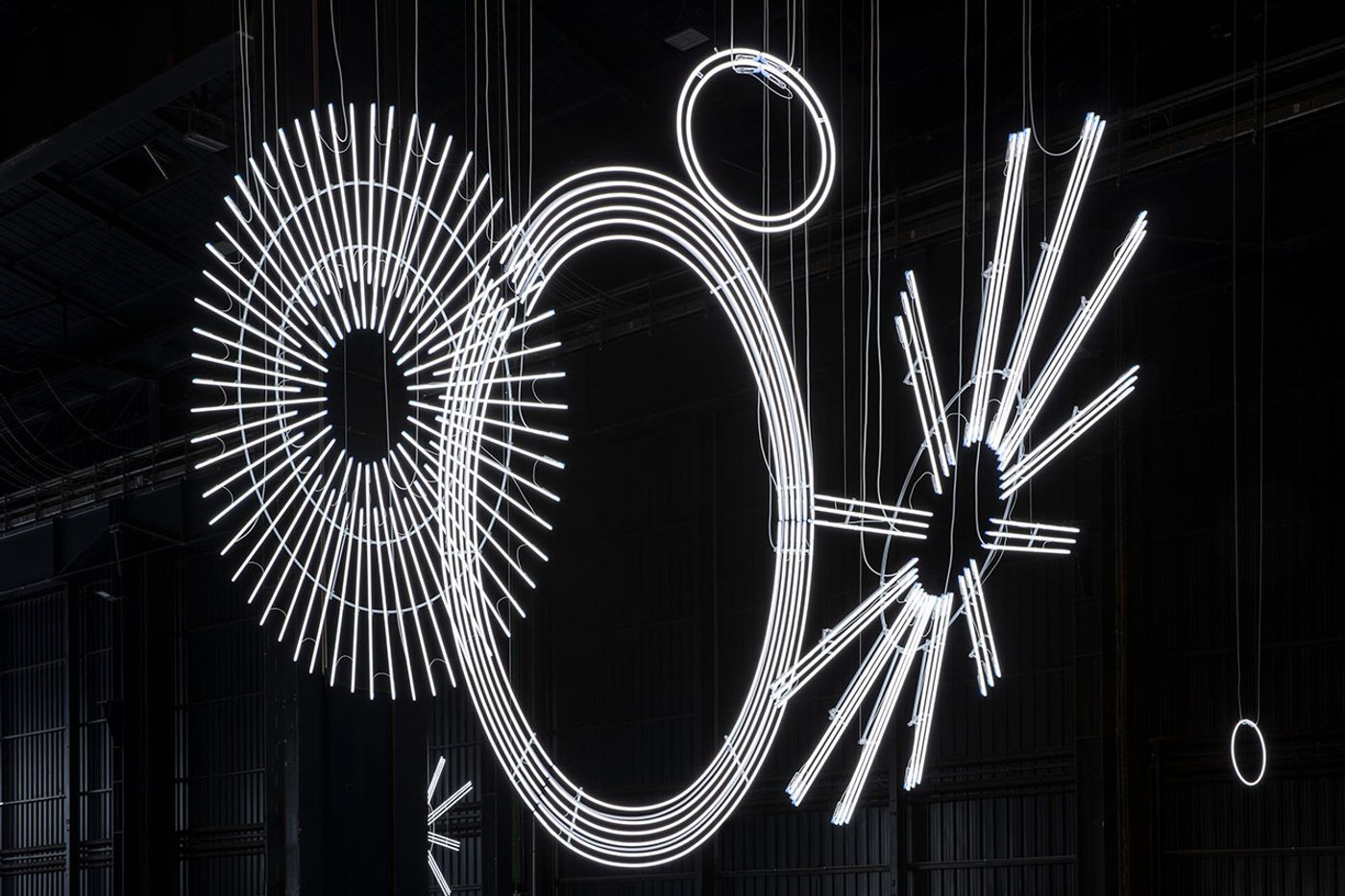
Cerith Wyn Evans, Radiant Fold (…the Illuminating Gas), 2017-2018. Installation view at Pirelli HangarBicocca, Milan, 2019. Courtesy of the artist; Amgueddfa Cymru – National Museum Wales and Pirelli HangarBicocca. Photo: Agostino Osio.

Cerith Wyn Evans, “….the Illuminating Gas”, exhibition view at Pirelli HangarBicocca, Milan, 2019. Courtesy of the artist and Pirelli HangarBicocca, Milan. Photo: Agostino Osio.
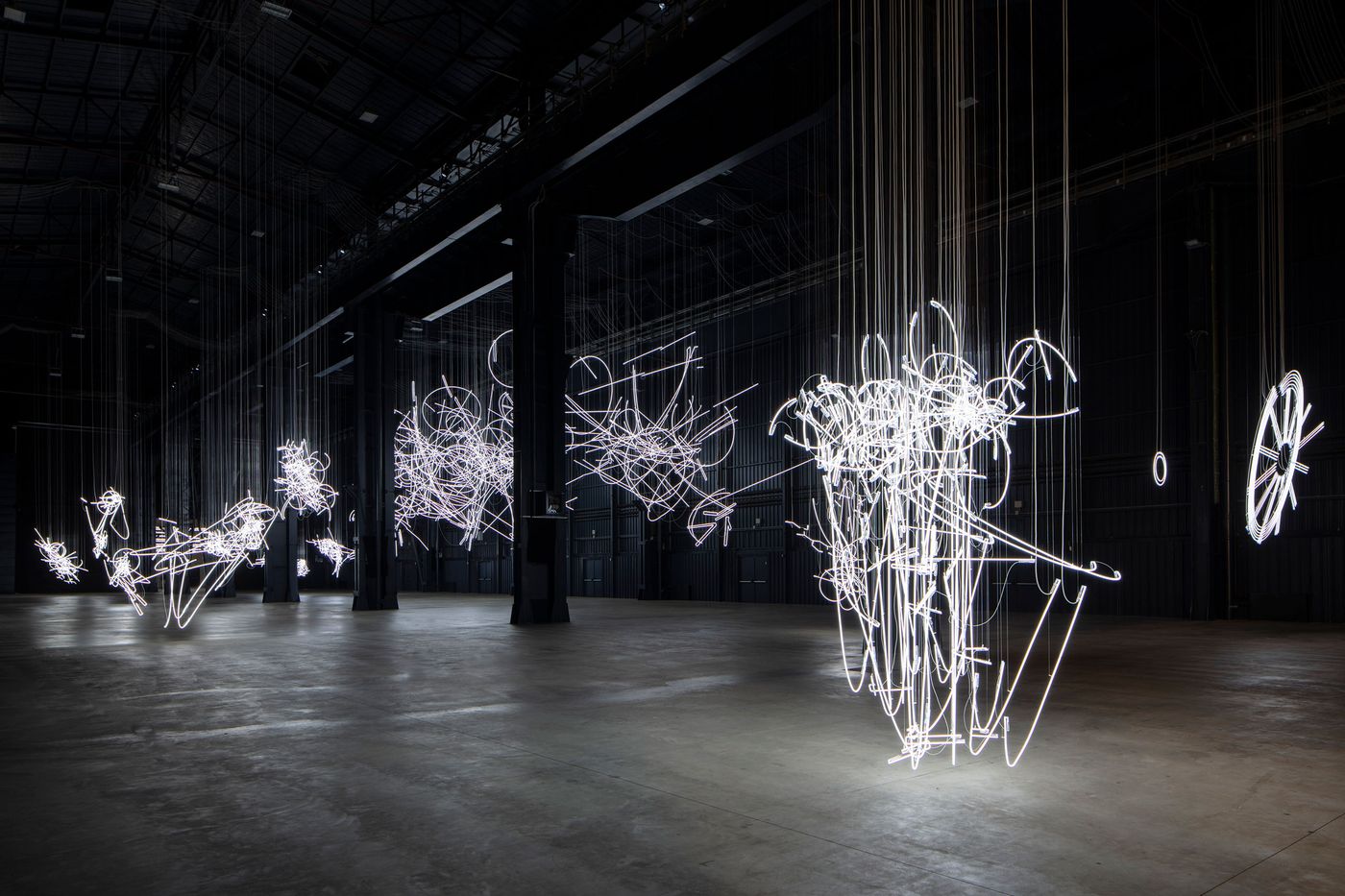
Cerith Wyn Evans, “….the Illuminating Gas”, exhibition view at Pirelli HangarBicocca, Milan, 2019. Courtesy of the artist and Pirelli HangarBicocca, Milan. Photo: Agostino Osio.
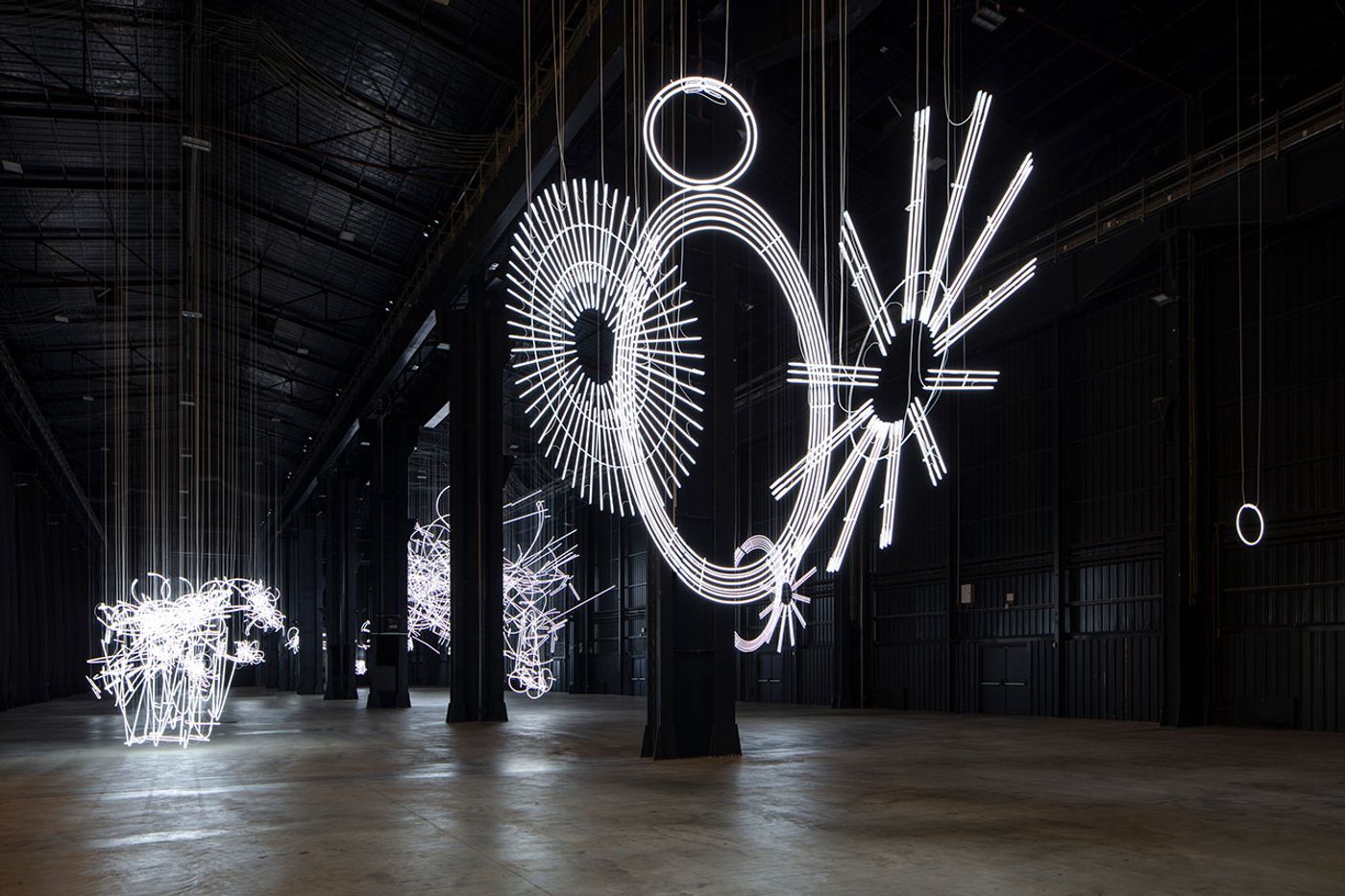
Cerith Wyn Evans, “….the Illuminating Gas”, exhibition view at Pirelli HangarBicocca, Milan, 2019. Courtesy of the artist and Pirelli HangarBicocca, Milan. Photo: Agostino Osio.
If the exhibition is an opera with light as its libretto, then the opening installation StarStarStar/Steer (totransversephoton) (2019) is the prelude. Consisting of seven 20-metre-high light columns made out of tubular lamps that are rhythmically switched on and off in the darkened hall, the pulsating, monumental work creates a choreography of lights and shadows. Eerily accompanied by a hissing soundtrack produced by the adjacent Composition for 37 flutes (2018), an ethereal glass sculpture also composed of transparent tubes, the mesmeric installation introduces visitors to Wyn Evans’ artistic universe.
Acts I and II take place in Pirelli HangarBicocca’s largest space, a 30-metre high, cathedral-like hall where an elaborate visual score unfolds consisting of two highly complex installations, the 13 neon sculptures that form the series Neon Forms (after Noh) (2015-2019) and the 2-kilometre-long tangle of neon lines and curves of Forms in Space... by Light (in Time) (2017). Originally conceived for the Duveen Galleries within Tate Britain in London and presented in Milan in a new configuration, Forms in Space... by Light (in Time) initially appears as a luminous tangled mess, but as you walk around and under it, the neon lines, curves and spirals start to form different shapes, triggering a deluge of references and connotations, from specific elements in Duchamp’s The Bride Stripped Bare by Her Bachelors, Even, (also known as The Large Glass), to the movement and gestures of Japanese Noh theatre. The codified movements of traditional Japanese Noh also form the basis for the Neon Forms (after Noh) series that poetically map - in three dimensions - how a certain role is staged. In this sense, the 13 neon clusters illuminating the grand hall form a troupe of incorporeal performers in dialogue with the larger neon installation.
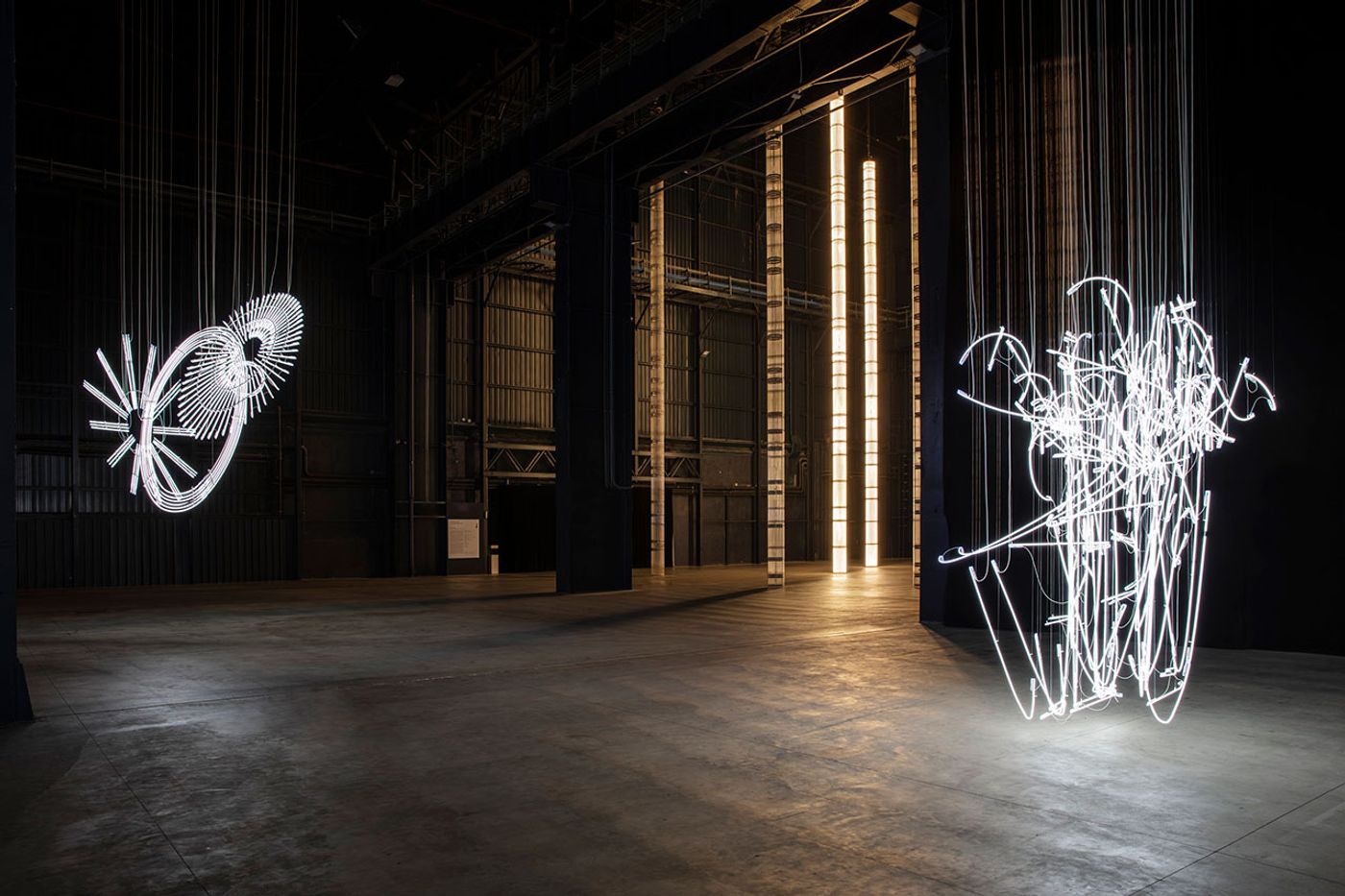
Cerith Wyn Evans, “….the Illuminating Gas”, exhibition view at Pirelli HangarBicocca, Milan, 2019. Courtesy of the artist and Pirelli HangarBicocca, Milan. Photo: Agostino Osio.

Cerith Wyn Evans, Neon Forms (After Noh), 2015-2019. Installation view at Pirelli HangarBicocca, Milan, 2019. Courtesy of the artist; White Cube; Marian Goodman Gallery, New York, Paris and London, and Pirelli HangarBicocca. Photo: Agostino Osio.
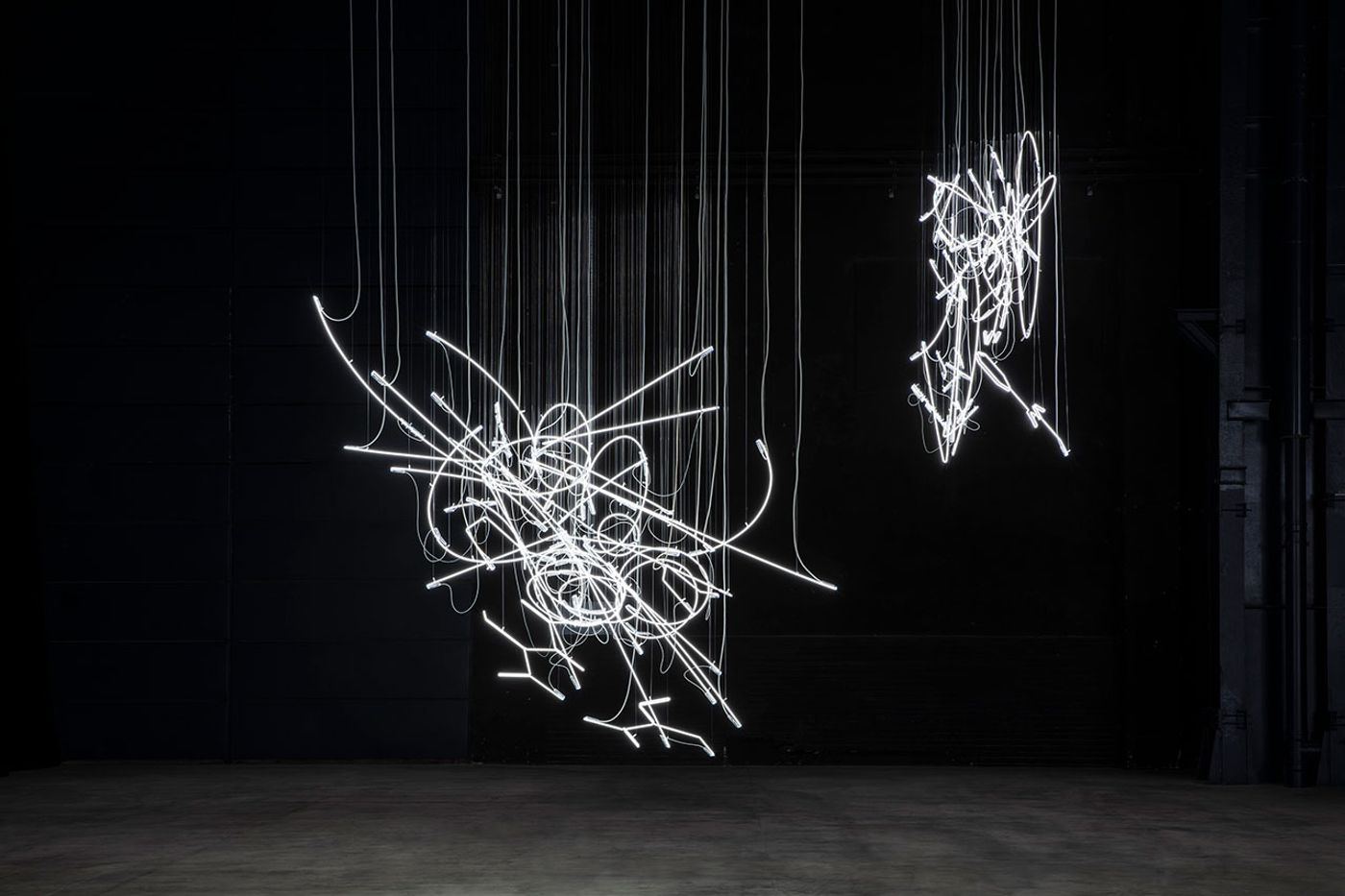
Cerith Wyn Evans, Neon Forms (After Noh), 2015-2019. Installation view at Pirelli HangarBicocca, Milan, 2019. Courtesy of the artist; White Cube; Marian Goodman Gallery, New York, Paris and London, and Pirelli HangarBicocca. Photo: Agostino Osio.

Cerith Wyn Evans, Neon Forms (After Noh XIII), 2018 (detail). Courtesy of the artist; Marian Goodman Gallery, New York, Paris and London, and Pirelli HangarBicocca. Photo: Agostino Osio.
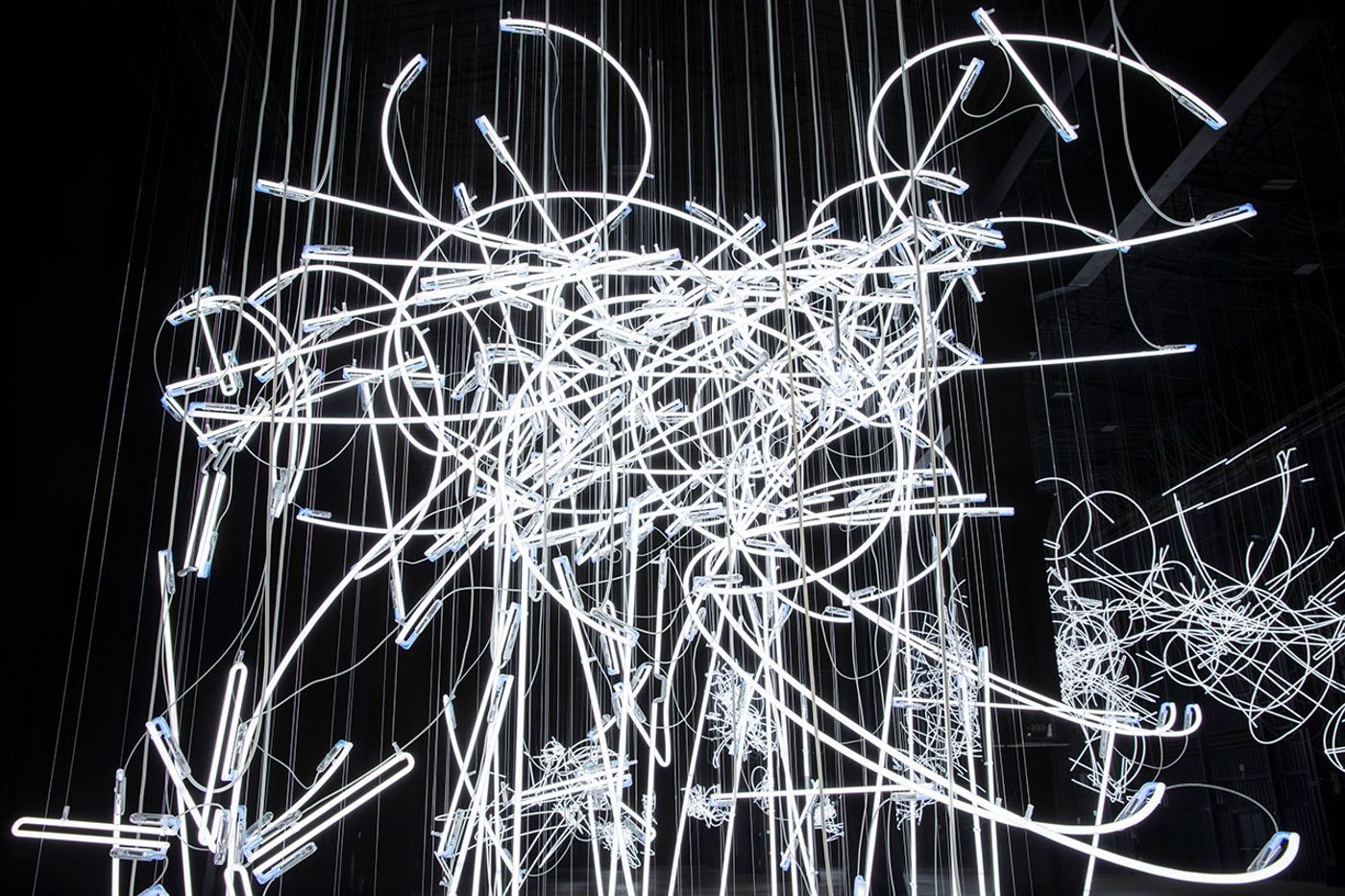
Cerith Wyn Evans, Neon Forms (After Noh I), 2015 (detail). Courtesy of the artist; White Cube and Pirelli HangarBicocca. Photo: Agostino Osio.

Cerith Wyn Evans, Forms in Space...by Light (in Time), 2017. Tate Britain Commission by Cerith Wyn Evans, Duveen Galleries. © Cerith Wyn Evans, courtesy White Cube. Photo: Joe Humphreys © Tate, London 2018.
Conceived as an epilogue, the final section of the exhibition brings together an eclectic collection of works that epitomise Wyn Evans’ artistic practice in relation to both mediums and ideas. An expansive neon text hovering above the visitors, E=C=L=I=P=S=E (2015), poetically describes the path of a solar eclipse across the Iberian Peninsula to southernmost Somalia. Nearby, a suspended mobile composed of reflective disks and directional speakers, C=O=N=S=T=E=L=L=A=T=I=O=N (I call your image to mind) (2010), blasts a polyphonic collage of various sources including Wyn Evans’ own piano arrangements and recordings by the Lovell radio telescope, while in the opposite side of the room, two palm trees casts shadows as they rotate on turntables, Still life (In course of arrangement...) V (2015), in reference to the dawn of cinema. Finally, two pairs of subversive Murano blown-glass chandeliers, S=U=T=R=A (2017) and Mantra (2017), emit flashing lights according to a composition written and performed by the artist, in what is a silent finale to Wyn Evans’ uncanny opera which fittingly concludes withTIX3 (1994), a whimsical exit sign that deals with beginnings and endings
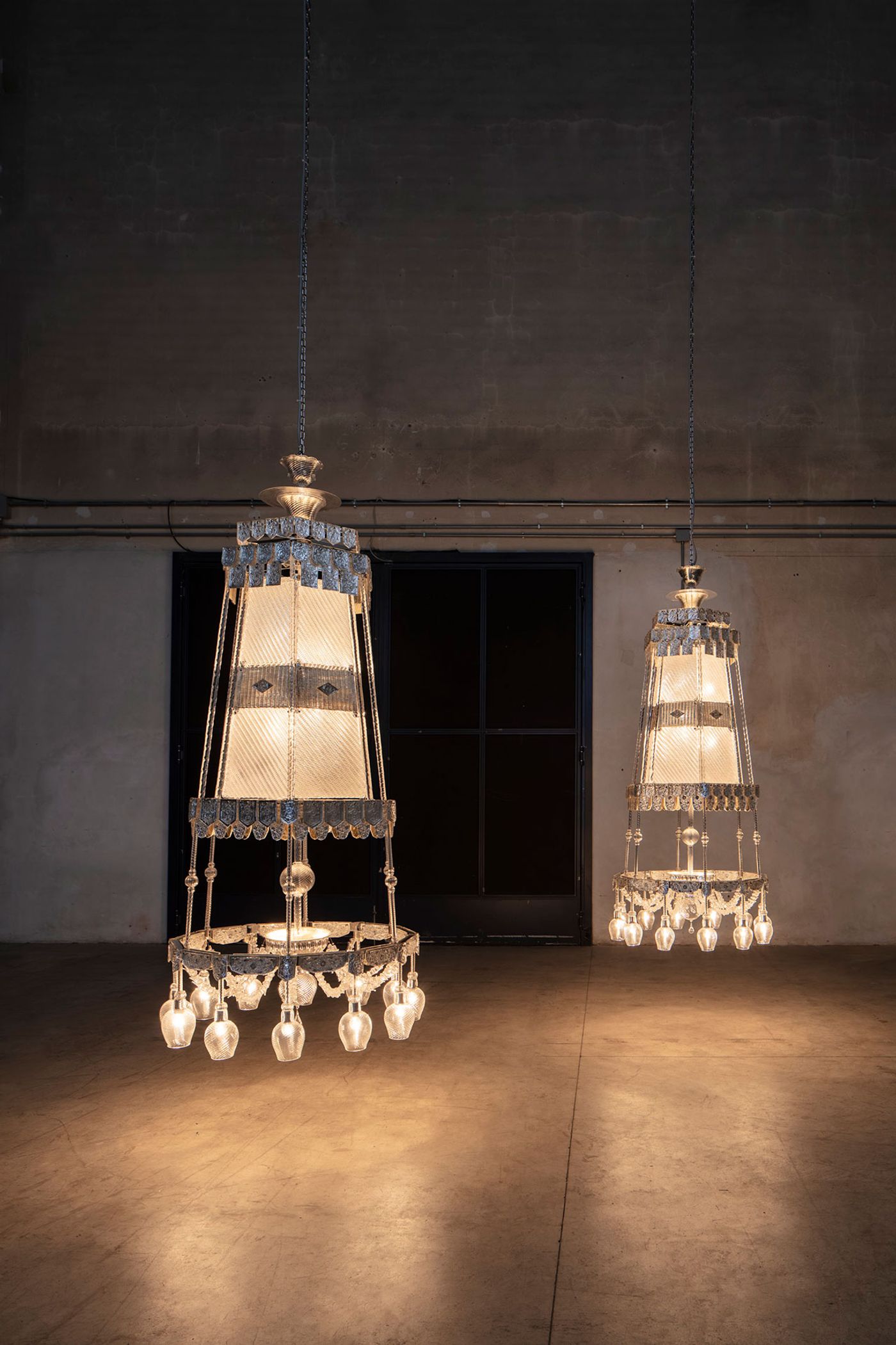
Cerith Wyn Evans, S=U=T=R=A, 2017. Installation view at Pirelli HangarBicocca, Milan, 2019. Courtesy of the artist; Marian Goodman Gallery, New York, Paris and London, and Pirelli HangarBicocca. Photo: Agostino Osio.
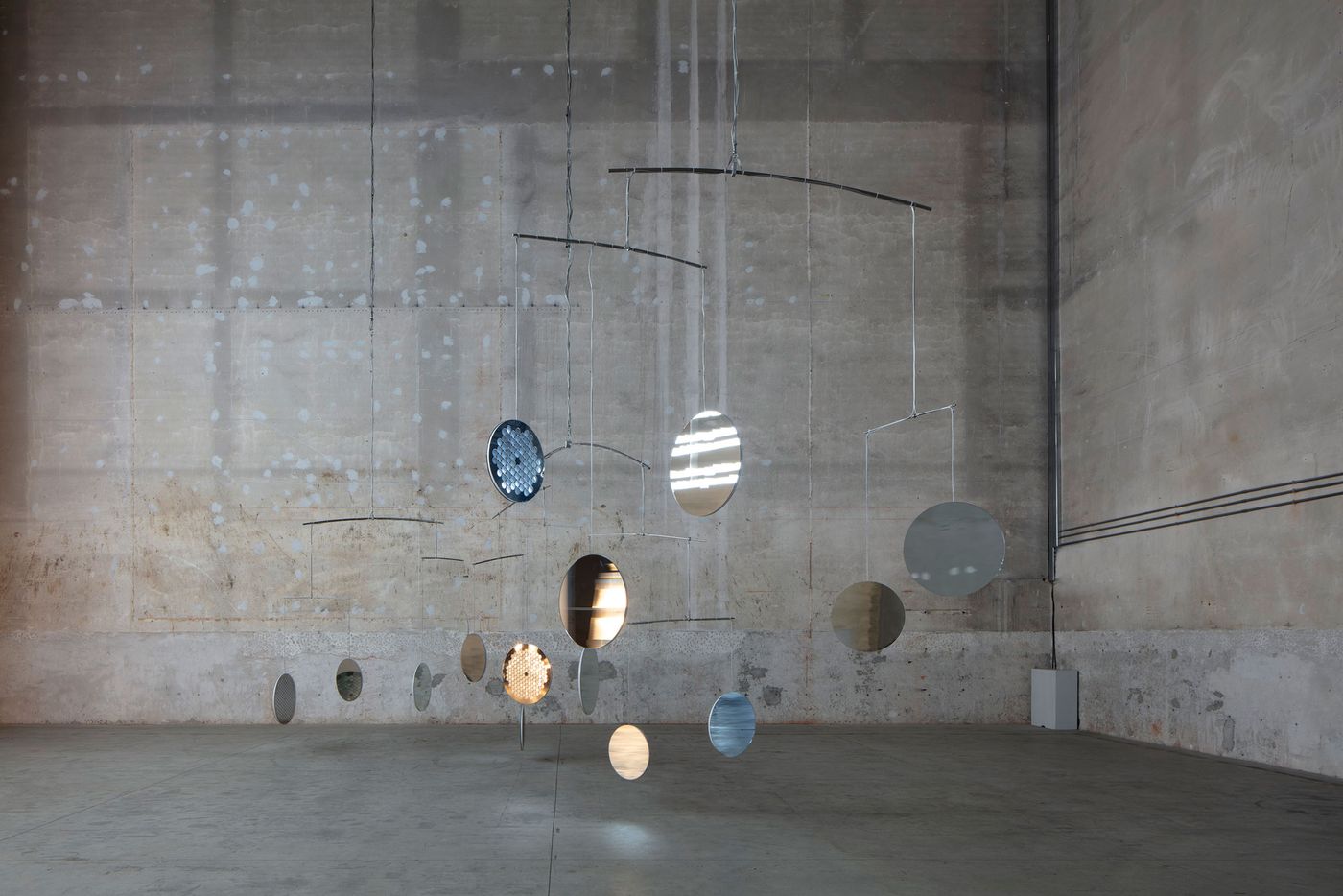
Cerith Wyn Evans, C=O=N=S=T=E=L=L=A=T=I=O=N (I call your
image to mind), 2010. Installation view at Pirelli HangarBicocca, Milan, 2019. Courtesy of the artist; Maja Hoffmann/Luma Foundation and Pirelli HangarBicocca. Photo: Agostino Osio.
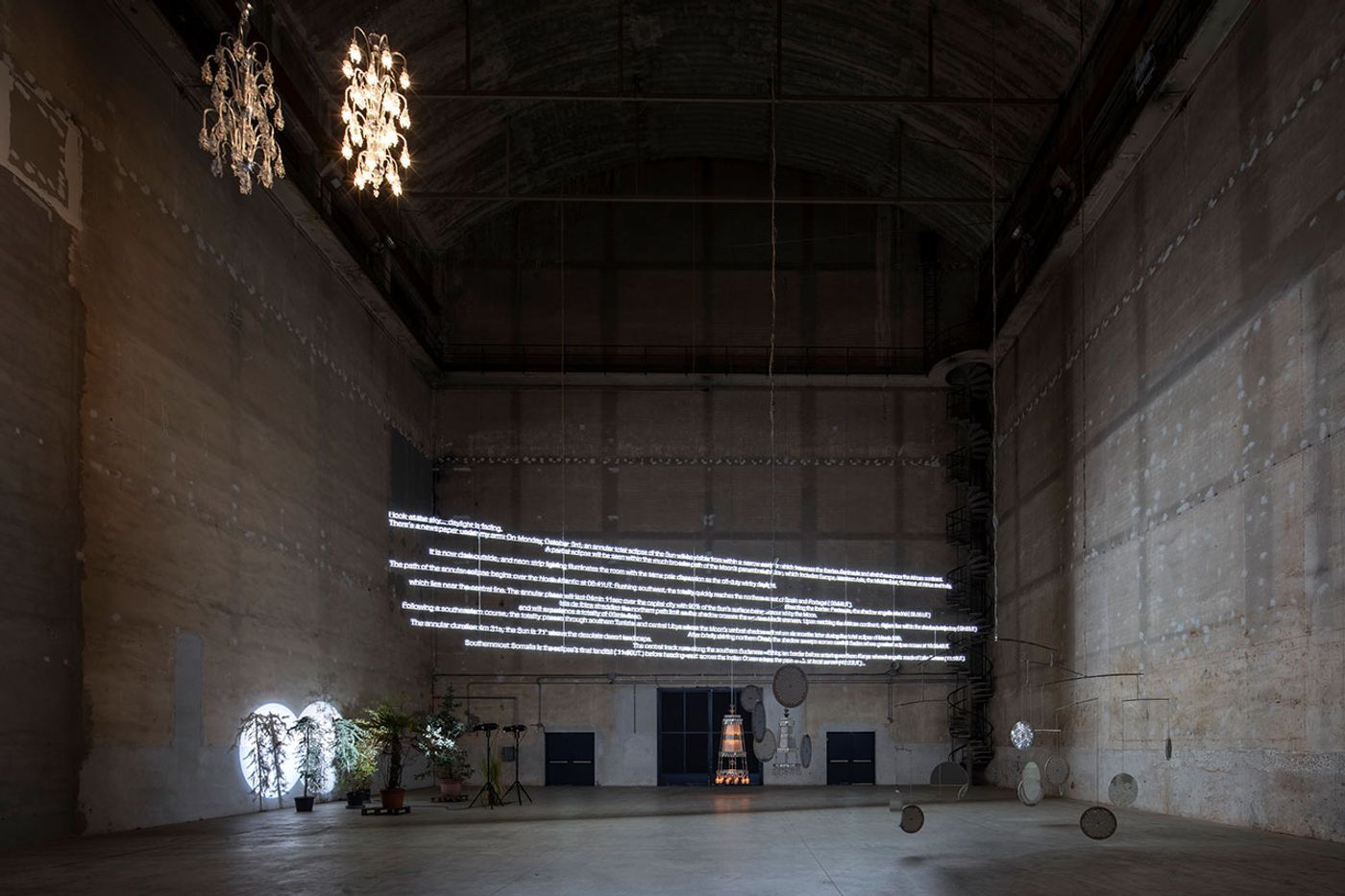
Cerith Wyn Evans, “….the Illuminating Gas”, exhibition view at Pirelli HangarBicocca, Milan, 2019. Courtesy of the artist and Pirelli HangarBicocca, Milan. Photo: Agostino Osio.
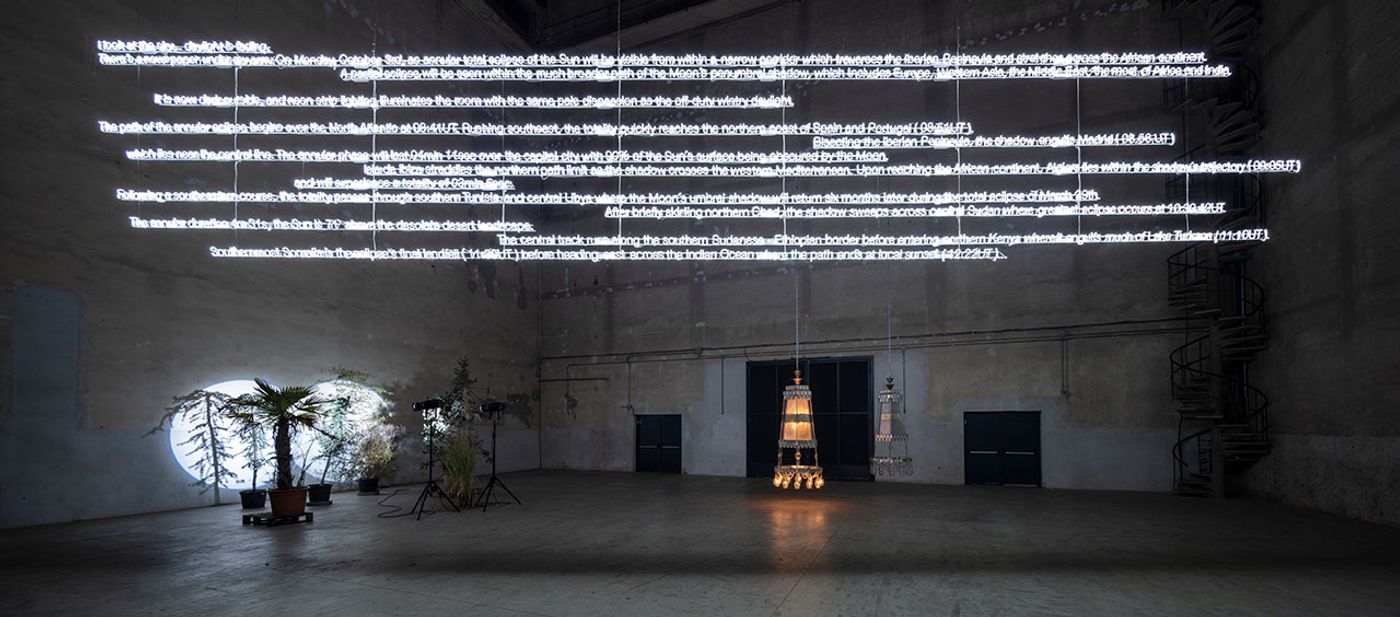
Cerith Wyn Evans, “….the Illuminating Gas”, exhibition view at Pirelli HangarBicocca, Milan, 2019. Courtesy of the artist and Pirelli HangarBicocca, Milan. Photo: Agostino Osio.
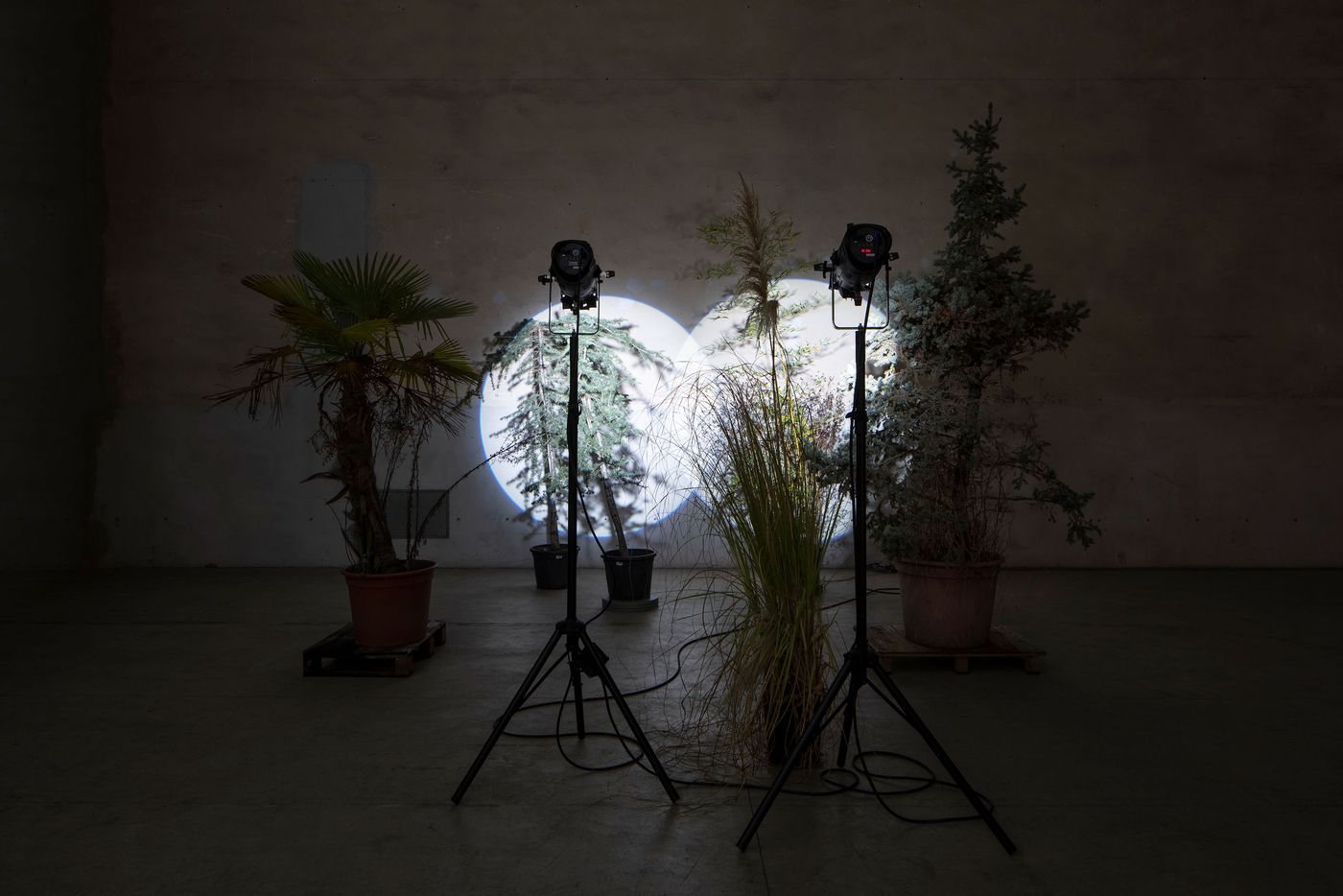
Cerith Wyn Evans, Still life (In course of arrangement...), 2019. Installation view at Pirelli HangarBicocca, Milan, 2019. Courtesy of the artist; White Cube and Pirelli HangarBicocca. Photo: Agostino Osio.
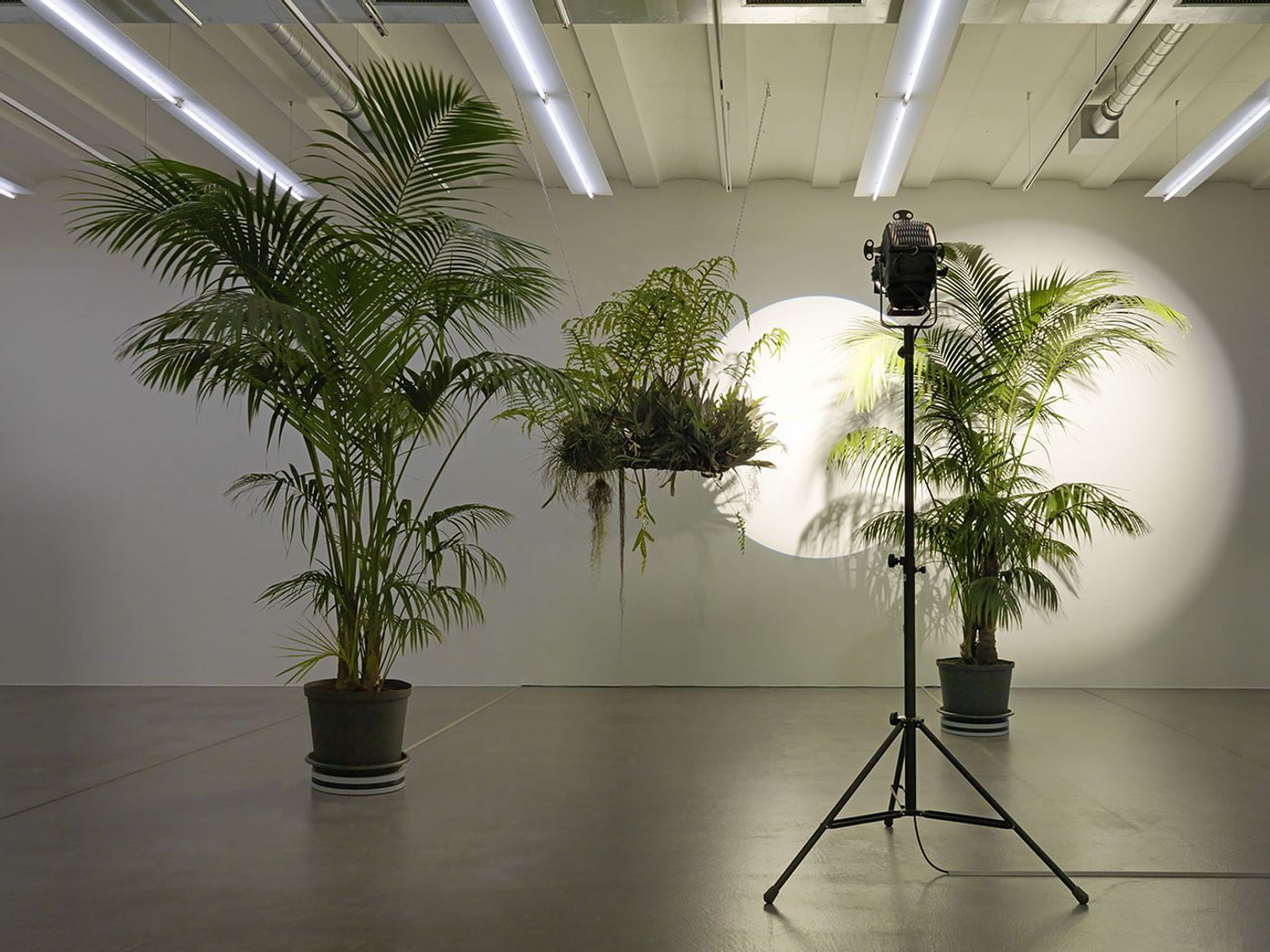
Cerith Wyn Evans, Still life (In course of arrangement...) V, 2017. Turntable with Phoenix roebelenii. Installation view, Museum Haus Konstruktiv, Zurich, 2017 © Cerith Wyn Evans. Courtesy Museum Haus Konstruktiv. Photo: Stefan Altenburger © Museum Haus Konstruktiv.
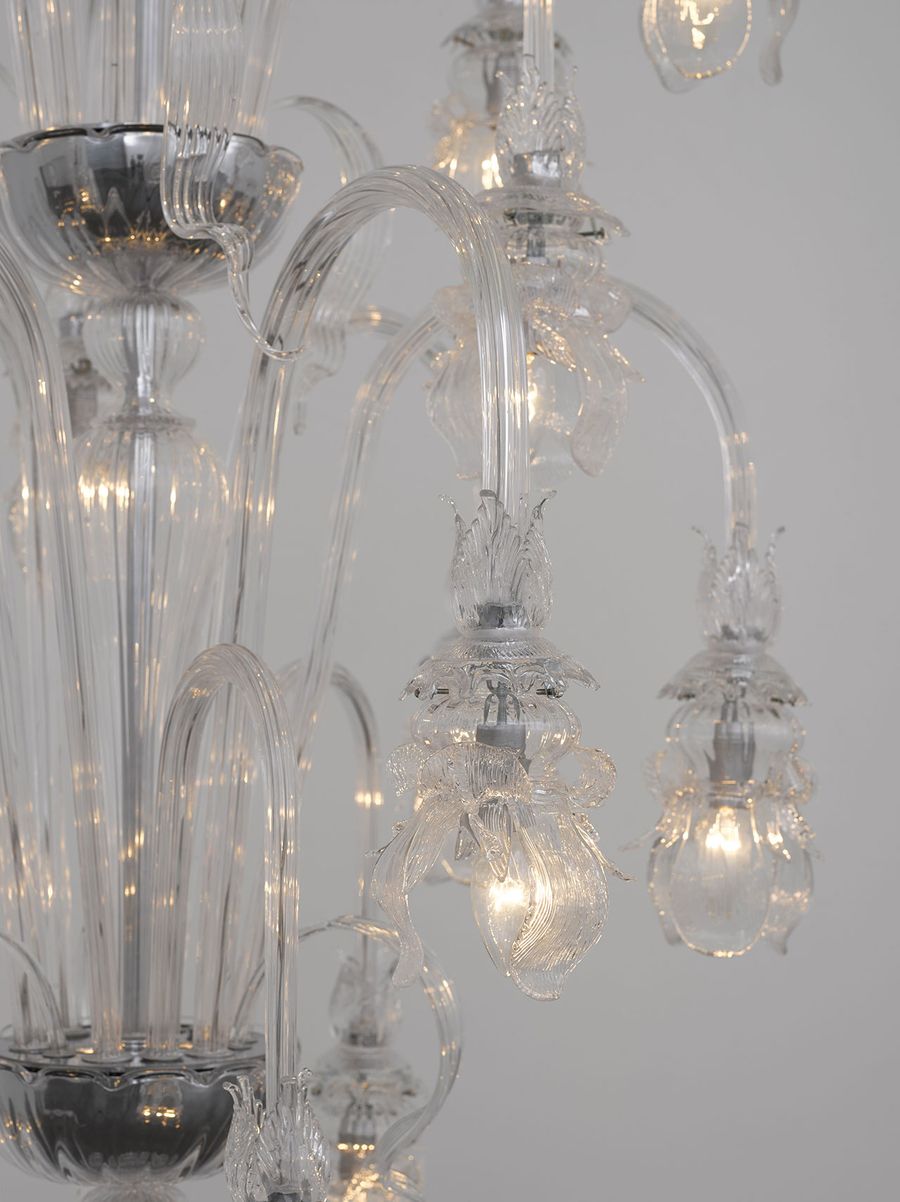
Cerith Wyn Evans, Mantra, 2016 (detail) © Cerith Wyn Evans. Courtesy White Cube. Photo: George Darrell.

Cerith Wyn Evans, Mantra, 2016 © Cerith Wyn Evans. Courtesy White Cube. Photo: George Darrell.
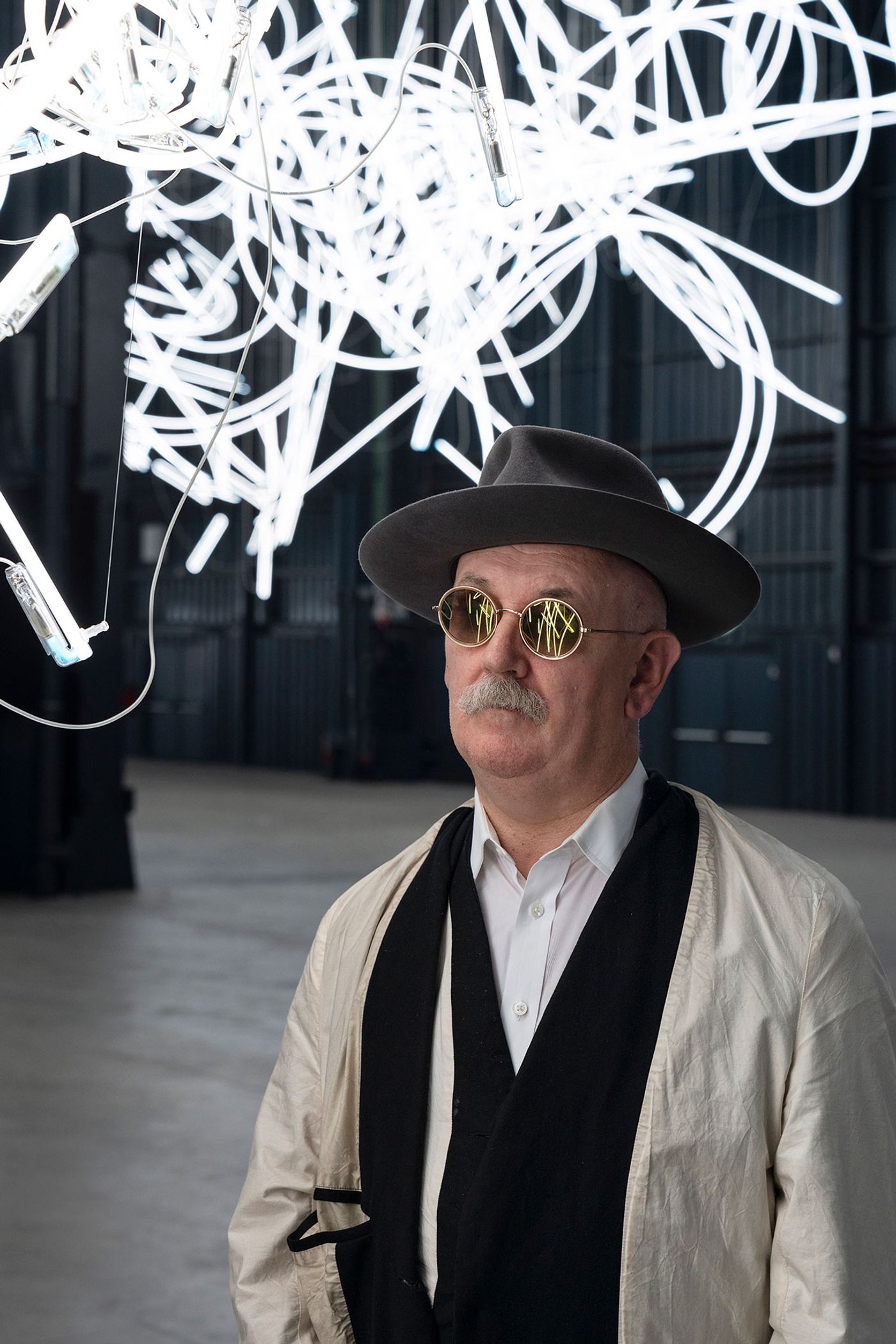
Cerith Wyn Evans portrait. Courtesy Pirelli HangarBicocca, Milan, 2019. Photo: Lorezno Palmieri.
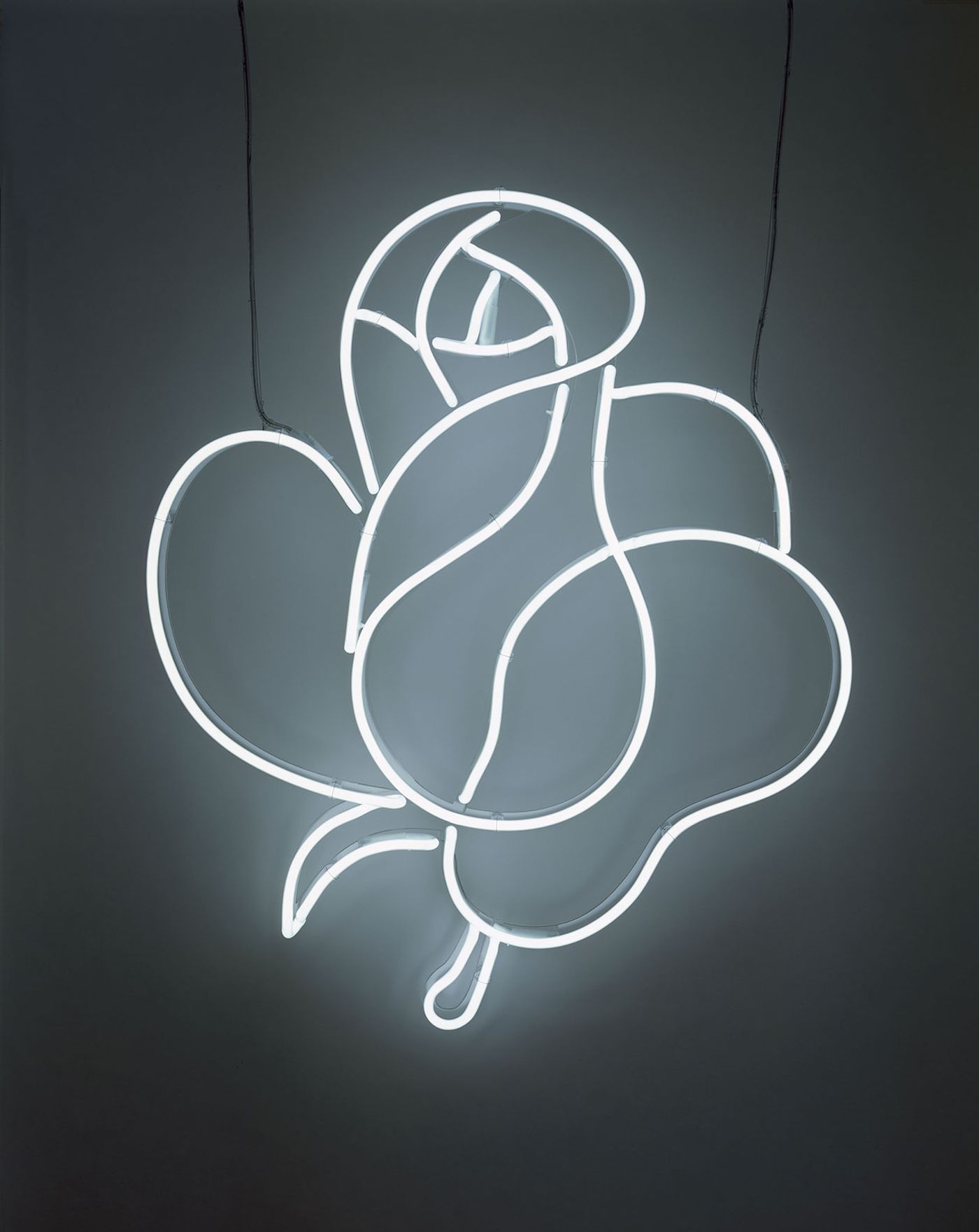
Cerith Wyn Evans, Untitled – Takashimaya Rose (White), 2007. © Cerith Wyn Evans. Courtesy White Cube. Photo: Todd-White Art Photography.
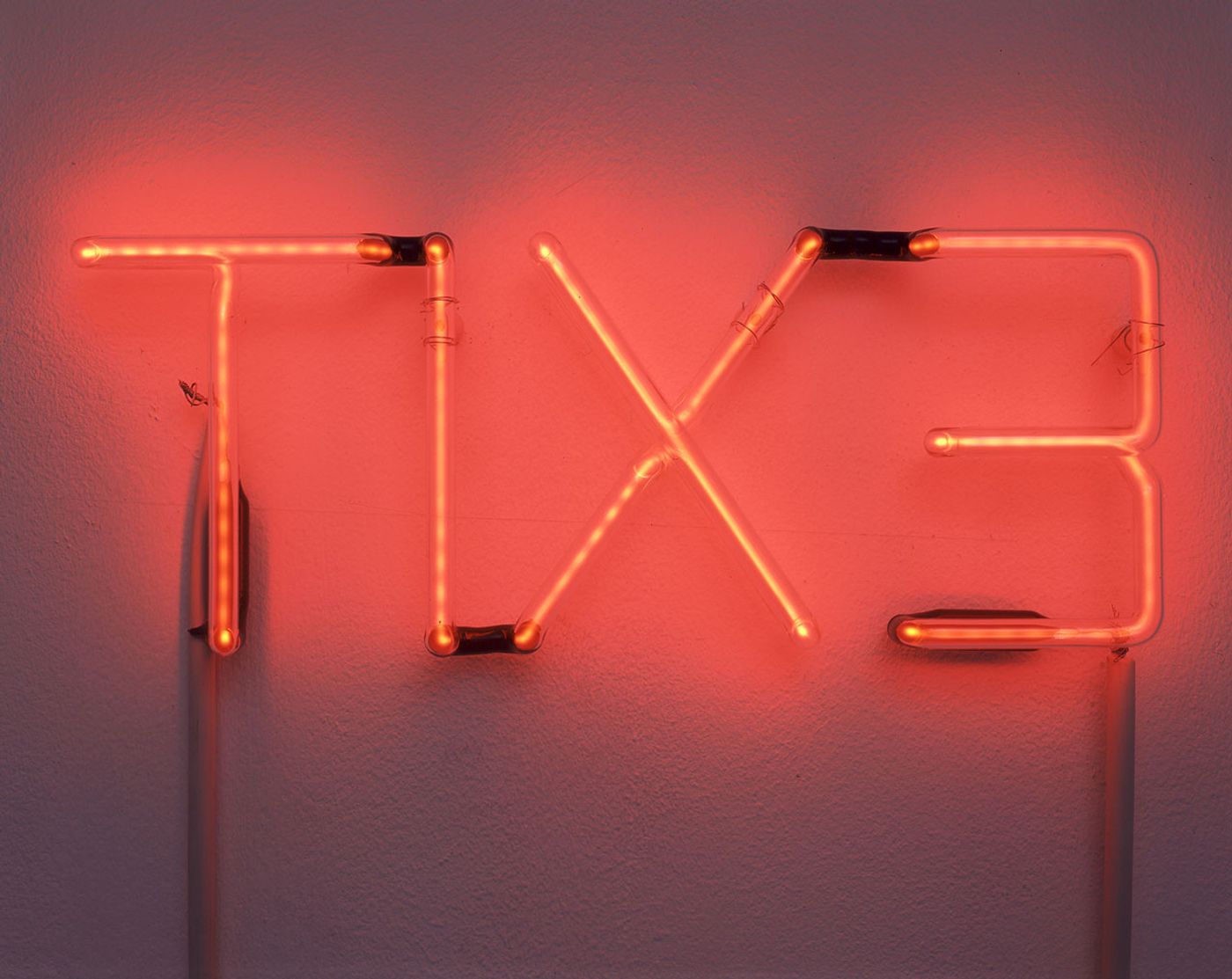
Cerith Wyn Evans, TIX3, 1996 © Cerith Wyn Evans. Courtesy White Cube Photo: Stephen White